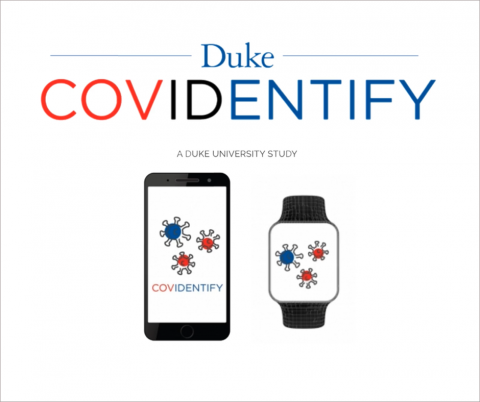Further Developing Duke's Wearable Infection Detection Platform (2024-2025)
Background
The Covid-19 pandemic highlighted the important role wearable devices can play in detecting illness early. Changes in physiologic and behavioral parameters have been measured by wearables during the course of infection. Anomalies in resting heart rate, heart rate variability, blood oxygen saturation, sleep patterns and physical activity have been shown to provide a time-series signature of infection in symptomatic as well as asymptomatic phases. As a result, such wearable “digital biomarkers” can be used to help predict, detect and monitor disease.
To ensure that new infections and clusters are identified before they promote viral spread, it is important to develop case-finding tools that help target diagnostic testing of individuals suspected to be infected. One such tool is Duke’s CovIdentify, a platform that integrates information from participants’ wearables with simple daily electronic self-reports on symptoms and social distancing. However, implementing existing digital biomarkers and creating new platforms to validate such analysis extends beyond Covid-19 and into the wider medical field.
Project Description
Building on the work of previous teams, this project team will build and refine an online infection detection platform that populates and translates wearable data from a variety of sources in an easy-to-use manner. The goal of this platform is to inform the onset and trajectory of illness for Covid-19 and other diseases (e.g., flu). The platform will also support future studies investigating the role of comorbidity and demographics in disease outcomes.
Team members will refine and continue to develop a custom wearable device and associated iOS application/web app for online infection detection. This will include implementation of previously trained health anomaly detection algorithms that processes the wearable data from the custom device and alerts of unexpected physiological changes that may indicate infection. Based on this detection algorithm, push notifications/text messages can be sent to the wearable device users alerting them of an anomaly with recommended best practices.
The team will also further develop visualization dashboards in order to provide easy-to-understand, real-time access to collected wearable data and an assessment of infection risk. The anomaly detection algorithm will be trained and tested using retrospective electronic health record and wearable data of approximately 1,500 Duke patients. Team members will therefore have an unprecedented opportunity to train and develop infection detection algorithms as a part of this project.
Anticipated Outputs
Refined and updated wearable data visualizations; trained and tested cloud-based infection detection algorithm; refined custom wearable device
Student Opportunities
Ideally, this project team will include 2 graduate students and 6 undergraduate students with interests in computer science, engineering, product design, data science, public health and communications. An eagerness to learn how to use technology and data to improve people’s access to healthcare is critical.
Undergraduate students will have the opportunity to develop skills in the literature review process, data science, UI/UX, wearable device development and data visualization. They will also practice communication skills by presenting during lab meetings and conveying their ideas in a succinct, clear manner.
Graduate students will have the opportunity to further research the development of digital biomarkers from this project if they choose. It is expected that all students contributing to the project will participate in writing at least one publication from this project.
See also the related Data+ project for Summer 2024; there is a separate application process for students who are interested in this optional summer component.
Timing
Summer 2024 – Spring 2025
- Summer 2024 (optional): Data+ students: Train and test machine learning algorithm; develop and refine data cloud engineering
- Fall 2024: Continue UI/UX storyboarding and implementation; develop and refine algorithm and software; develop and refine data; continue data cloud engineering
- Spring 2025: Continue algorithm and software development; troubleshoot technical issues; continue device testing and refinement; continue data cloud engineering
Crediting
Academic credit available for fall and spring semesters; summer funding available
See related Data+ summer project, Further Developing Duke’s Wearable Infection Detection Platform, and earlier related team, Refining and Expanding Duke’s Wearable Infection Detection Platform (2023-2024).
Image: Video still from CovIdentify website

Team Leaders
- Jessilyn Dunn, Pratt School of Engineering-Biomedical Engineering
- Ali Roghanizad, Pratt School of Engineering-Biomedical Engineering
/graduate Team Members
-
Lauren Lederer, Biomedical Engineering-MS
